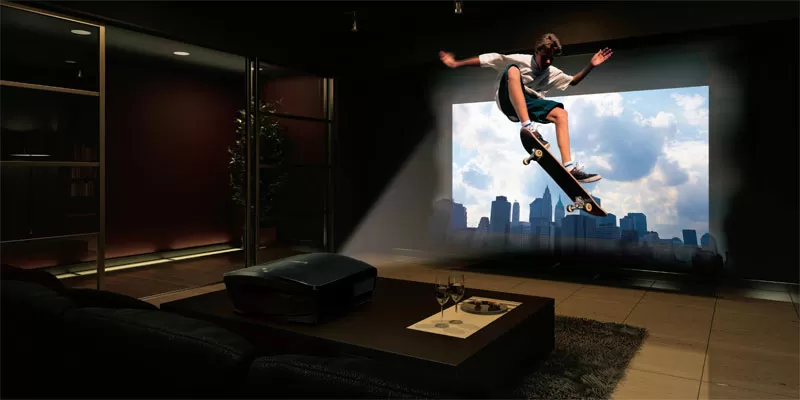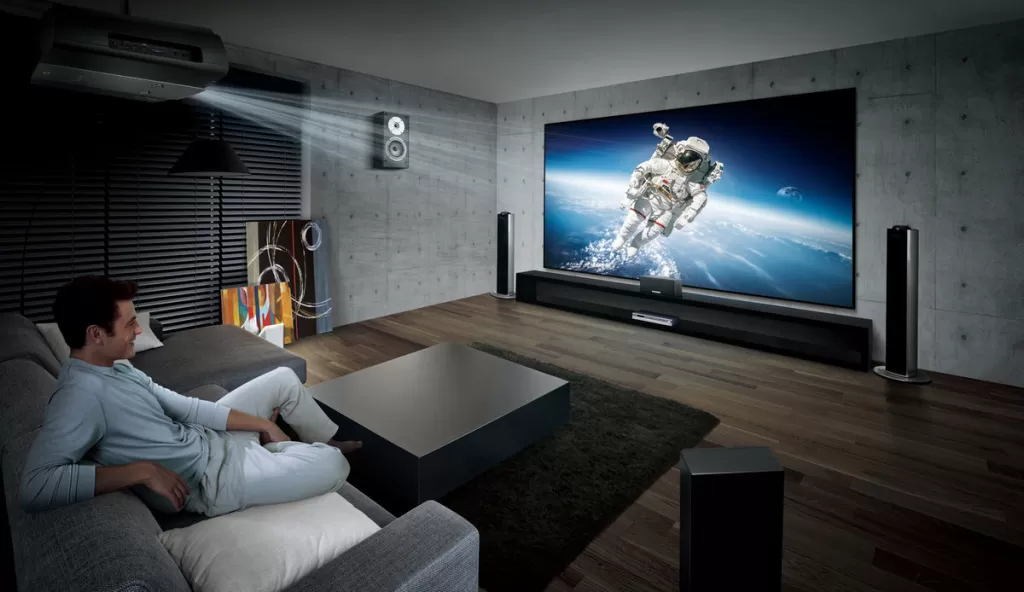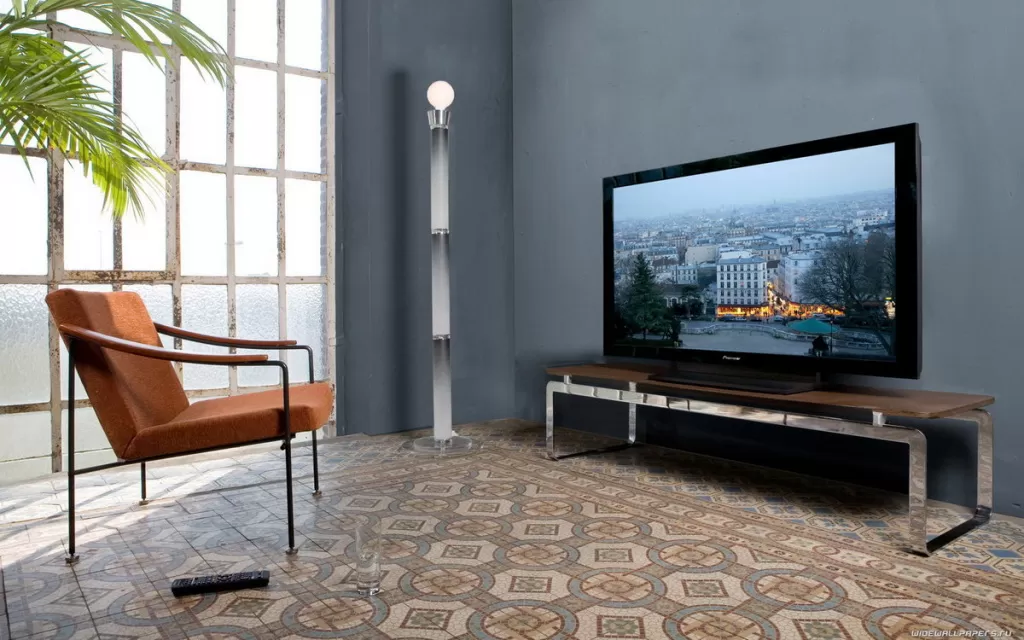If you want to organize a real home theater in your apartment to watch your favorite movies and series on the big screen, then you cannot do without high-quality equipment. And the choice arises — which is better to buy, a projector or a TV? And the answer to this question is not as clear as it seems.
Let’s figure out what is better to buy — a projector or a TV — to arrange interesting family evenings with microwave popcorn.
Compare three parameters:
-
Which is bigger and more beautiful;
-
Which is easier to install, learn and use;
-
Which is cheaper.
And the results of the comparison can be quite surprising.
TV and projector screen size

In the battle for superiority in terms of screen size, the projector will win, of course. He can be tens of meters! At home, such sizes, of course, are difficult to achieve. However, a three-meter screen diagonal is quite feasible.
TVs seem to have no upper diagonal limit. But, if you open the website of a well-known electronics store with a corporate orange color, it turns out that models with a diagonal of more than 75 inches can be counted on the fingers of one hand. There are also 85–100-inch models, but they cost … seven figures.
In general, in the battle of sizes, the projector wins.
Image quality on TV and projector
But it’s not just the screen size that matters. Image quality also matters. And here the projector loses to the TV screen in all respects.
Even in a completely dark room, the projected “picture” will be too “white”. However, you yourself watch it in the cinema. Black that looks gray is one of the biggest problems. The fact is that the matrix of this device is basically transparent, and behind it is a powerful lamp. It is impossible to achieve high contrast in such conditions.
The projection of the “picture” also “eats” the colors. The image looks dull, devoid of richness of shades. All these bright colors are “thought out” by the brain, trying to “fit” the picture to something familiar.
It is impossible to achieve absolute white, no matter how sad it may be. The matrix is transparent, but has a distinct grayish tint due to the layer of current-carrying conductors. And this also leads to a decrease in the saturation of colors, including white.
The TV screen, with its reflective layer behind the panel of image-forming LEDs, is devoid of these shortcomings in principle. Its color, contrast and saturation of shades is very high.
So in the battle for image quality, definitely TV wins.
However! There is a special kind of projectors — laser. They use a unique image projection technology that delivers high quality. Laser projectors in terms of brightness, saturation and contrast are approaching the TV screen.
Laser projectors have only a couple of problems. Firstly, they are quite rare on the market. Secondly, they are corny expensive — even a model from Xiaomi, which is sold in the “mid-budget” price segment, costs about 20$ dollars. For this money, it is quite possible to purchase a large and beautiful TV.
Easy to install and use TV and projector

Now let’s deal with such “little things” as ease of installation.
If you want to hang a TV in the hallway, you will need:
-
Drill a wall and hang one part of the bracket on it;
-
Attach the second part of the bracket to the TV;
-
Hang TV on the wall;
-
Connect the extension cord to the outlet if necessary.
If you want to install a TV, you will need:
-
Install TV on the bedside table;
-
Connect it to the mains.
With projectors it will be a little more complicated:
-
Hang screen. It is usually attached to the ceiling;
-
Connect power to the screen, if required (if it is with automatic opening);
-
Hang the projector on the ceiling;
-
Run the cables to the projector. You will need to run power and image (HDMI/DVI) wires. Usually they are hidden behind the false ceiling and in the wall, but with the repair already completed, you can also forward the cable channel;
-
Install an audio system in the room;
-
Lay cables from the audio system;
-
Connect the audio and projector cables to the computer.
No, of course, you can not complicate it once again and place the projector on the opposite wall on the bedside table. But in any case, when installing such a system, there will be much more work than when using a TV.
The problem lies in the fact that the projector will need to connect different devices to work in different situations. Want to watch live TV? The receiver is connected. Want to watch a movie on your computer? The receiver turns off, the computer connects. And in all cases, an external audio system is required.
So in terms of ease of installation and use, the TV also wins.
TV and projector price

And now to the most important for some users to prices.
The vast majority of TV models, if you look at online stores, cost about 500 $. We consider large (with a diagonal of 40 inches) and good image quality. For 500 $, you can get a device ready for connection.
But home theater requires more than just a TV. Full list:
-
Television;
-
Audio system 5.1.
Let’s try to pick:
-
LG 4K TV with a diagonal of 65 inches (165 centimeters) — 580 $;
-
Sony home theater (1000 W 5.1 acoustics, DLNA and Wi-Fi support, the ability to output sound from an external source via optics, including 5.1 channels) — 250 $.
Total 830 $ - and you have a real cinema in your home with a huge screen, amazing picture quality and excellent sound.
Now to the projector. Let’s try to pick:
-
Epson bright 3LCD projector (Full HD resolution, maximum diagonal up to 10 meters, customizable, 3D support) — 550 $;
-
150-inch matte white Cactus Wallscreen — 80 $;
-
Sony home theater (5.1 audio, 1000 W, supports optical connection and DLNA) — 250 $.
Total 880 $ – and you can watch movies on the big screen! However, there are a couple of “buts” in assemblies:
-
The TV has a much higher resolution, if you watch UHD video, it will be impressive. 4K projectors cost many times more;
-
The projector has a diagonal of up to 150 inches with this screen. The TV in any case will be 65 inches.
Prices are current as of March 2019. In addition, the optimal configurations have been selected, but you can pick up something of your own, with other technical characteristics and, accordingly, cost.
Conclusion
We did not take into account one important feature — no popcorn, no chairs will create a real cinema atmosphere if the film is shown on TV. Only a projector is able to give the magic of viewing. There is something “ritual” in this curtaining of windows, lowering the screen and a bright white spot immediately after switching on, something that sets you in a completely different way, when all vital issues remain outside the room, and you are immersed in watching a movie.
In general, TVs outperform projectors in almost every way, including image quality, ease of installation, and average price. But not in screen size. A truly large diagonal, like in a movie, can only be achieved with a projector.

Добавить комментарий
Для отправки комментария вам необходимо авторизоваться.